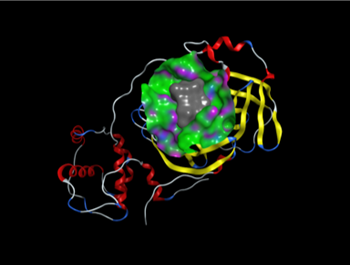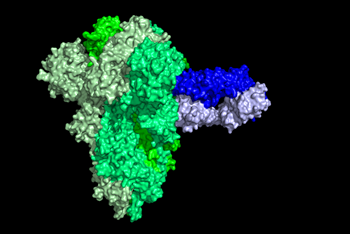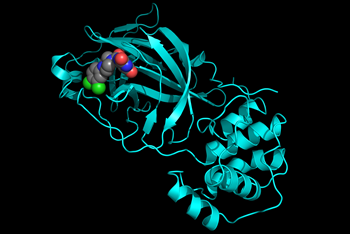Molecular Design Highlights
Novel molecules have been designed as potential inhibitors of the viral main protease. As part of the National Virtual Biotechnology Laboratory, a U.S. Department of Energy consortium dedicated to COVID-19, researchers are designing novel molecules as potential inhibitors of the SARS-CoV-2 viral main protease, an enzyme that plays an important role in viral replication and thus infection. After the virus infects a human cell, the infected cell reads the viral RNA – the instructions that define the viral genome – and makes a single protein chain that contains 16 viral proteins, all connected together. The viral main protease cuts apart that single protein chain into 16 mature, individual proteins, and is therefore necessary for the virus to replicate and infect other cells. The research team is hunting for small molecules that block the protease from making those cuts as a potential future therapeutic for COVID-19. Made for the first time by synthetic chemists, the new inhibitors contain unique electrophiles, chemical groups that connect directly to an important sulfur atom in the viral main protease by accepting electrons. Once researchers experimentally test and validate the inhibitors in a biochemical assay for the SARS-CoV-2 main protease, they will use computational algorithms to further design modifications to improve electron affinity and other properties of the original designer molecule.

Employed artificial intelligence (AI) methods to computationally screen 1040 possible antibody variations, identifying ~300 potential hits. These antibodies were made and experimentally screened against the SARS-CoV-2 Spike.

Used an integrated computational and experimental platform enabled by DOE’s high- performance Leadership Computing Facilities and supported by structural biology studies at DOE’s light, neutron and nanoscale science user facilities, to screen 10s of millions of small molecules against more than 100 binding sites of the SARS-CoV-2 viral proteins. From these computational screening studies, 2000 small molecules were experimentally evaluated, and 56 of those molecules show some inhibition of viral infection in the cell-based assay. These 56 hits are being confirmed in an independent antiviral screen, and experiments are on-going to understand what parts of the viral lifecycle are being inhibited by each confirmed hit. Separately, the same integrated computational and experimental platform enabled the design and optimization of small-molecule viral protease inhibitors, resulting in the identification of several promising antiviral agents that are being further evaluated by academic and pharmaceutical partners.


